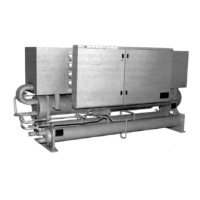16 Product Manual WHR-2
Correction factors for delta-Ts other than 10 degrees are in Table 3 and Table 4. Exceeding the
Delta-T range of 6 to 16 degrees will cause problems controlling unit unloading.
• Condensing temperatures (CT) from 105°F to 125°F (40°C to 55°C).
• Total Heat Rejection (THR) is given and used to select the condenser, whether it be a dry air-
cooled condenser or an evaporative condenser.
Several different size condensers can usually be matched to any given WHR-EA unit depending on
the condensing temperature that typically ranges from 20 to 30 degrees F above the design outdoor
temperature. Increasing condensing temperatures will reduce the chiller capacity, increase its power
consumption and result in a smaller condenser being required.
Normally a WHR-EA is selected to meet or exceed the required cooling capacity at some
condensing temperature and a condenser then selected with sufficient capacity to handle the heat
rejection with the selected temperature difference (TD, difference between design outdoor dry bulb
temperature and condensing temperature).
A more accurate solution can be achieved by plotting the capacity of the chiller and the condenser
as a function of the TD and observing the curves intersection that is the system balance point. An
example is shown in the following "Selection Example" section.
Sample Selections
Given: Required capacity of 100 tons cooling 240 gpm of water from 54°F to 44°F with 95°F design
dry bulb temperature. Evaporator fouling factor of .00025.
Find:
1. WHR water chiller and AC/AQ condenser selection
2. Compressor power input, chilled water pressure drop
Solution:
1) From Table 13, several WHR selections are possible:
a) WHR 110EA at 110°F CT; 102.5 tons, 107.3 kW, 1596.5 THR, 1.05 kW/ton
b) WHR 115EA at 115°F CT; 101.0 tons, 112.8 kW, 1597.3 THR, 1.12 kW/ton
c) WHR 120EA at 125°F CT; 103.4 tons, 135.1 kW, 1701.5 THR, 1.30 kW/ton
Note that the condensing temperature has significant influence on the chiller efficiency.
Progressing from a) to c) above will require smaller condensers, offset by larger, more
expensive chillers and lessening efficiency.
2) A condenser can be selected with the above information. For this example, a McQuay Model
ACAQ air-cooled condenser will be selected using selection procedures and data contained in
Product Manual PM ACAQ. A model ACD (double row of fans, standard fan speed) will be
used.
a) For the WHR 110EA at a TD of 15 degrees F (110°F - 95°F) no selection appears possible
based on the simple selection method. However, it is close and the graphical method may
give a solution.
b) For the WHR 115EA at a TD of 20 degrees, a Model 175A will do the service.
c) For the WHR 120 EA at a TD of 30 degrees, a Model 115A will do the service.
Selection c) will prove to be considerably lower in first cost but carries a 16 percent efficiency
penalty.

